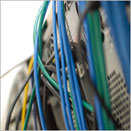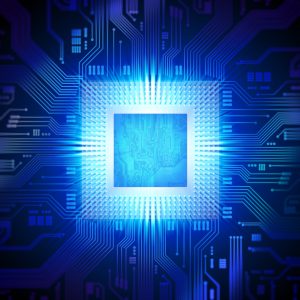Data Center Networking — building efficient and intelligent fabrics for millions of servers Data center networking (DCN) is a crucial part to support efficient operations of online services in the cloud. We investigate paradigm-shifting technologies to build high availability, high reliability and high-performance network fabric for our data centers.
Data center networking (DCN) is a crucial part to support efficient operations of online services in the cloud. We investigate paradigm-shifting technologies to build high availability, high reliability and high-performance network fabric for our data centers.
Past Projects:
- Cloud-scale Network Function Virtualization
- Programming Reconfigurable Hardware for Virtualized Network Functions (more)
- Checkout our ClickNP paper in SIGCOMM 2016!
- Multi-path transport protocols for data center networks (more)
- Checkout our FUSO paper in ATC 2016!
- Multicast and low-latency routing: Datacast (opens in new tab) (CoNEXT’12), RDB (opens in new tab) (CoNEXT’13)
- Congestion control: ICTCP (opens in new tab) (CoNEXT’10 – Best Paper), ECN* (opens in new tab) (CoNEXT’12)
- Network management: Address Configuration (opens in new tab) (SIGCOMM’10)
- Virtualization: SecondNet (opens in new tab) (CoNEXT’10), ServerSwitch (opens in new tab) (NSDI’11 – Awarded Best Paper)
- Our pioneer work in DCN, on network architecture: DCell (opens in new tab) (SIGCOMM’08), BCube (opens in new tab) (SIGCOMM’09)
FPGA for the cloud — empowering the cloud with reconfigurable hardware
 We foresee that the re-configurability and high parallelism of FPGA will fundamentally change the way we are serving online services. We are investigating the cutting-edge technologies for better programming FPGAs and empowering our services in the cloud. We have demonstrated that using FPGA can significantly accelerate Deep Neural Networks in the cloud.
We foresee that the re-configurability and high parallelism of FPGA will fundamentally change the way we are serving online services. We are investigating the cutting-edge technologies for better programming FPGAs and empowering our services in the cloud. We have demonstrated that using FPGA can significantly accelerate Deep Neural Networks in the cloud.
Past Projects:
- Going Deeper with FPGA (more)
- Checkout our FPGA ’16 paper on Angel-Eye!
Software radio — empowering wireless revolution with the magic of software
 We foresee that the increasingly powerful multi-core architecture and parallel data processing will fundamentally change wireless communications. Software-based cognitive wireless systems will become much more powerful, flexible, and efficient compared with existing wireless technologies. The enabling technology is software radio (or software-defined radio, SDR). For the past several years, we have strike to build the best software radio in a very different way, and to develop programming models and tools that will greatly reduce the effort involved in implementing state-of-the-art wireless systems.
We foresee that the increasingly powerful multi-core architecture and parallel data processing will fundamentally change wireless communications. Software-based cognitive wireless systems will become much more powerful, flexible, and efficient compared with existing wireless technologies. The enabling technology is software radio (or software-defined radio, SDR). For the past several years, we have strike to build the best software radio in a very different way, and to develop programming models and tools that will greatly reduce the effort involved in implementing state-of-the-art wireless systems.
- Publication: Sora (opens in new tab) (NSDI’09 – Best Paper, CACM version (opens in new tab))
- Sora is open-source at GitHub (opens in new tab).
Wireless Networks — computational thinking in the traditional field
 The explosive increase in mobile usage demands constant revolutions in wireless technology. We have been engaged in a broad range of wireless research in PHY, MAC, cross-layer, MIMO, dynamic spectrum, whitespace, measurement, reliability, etc. Our approach has been one with “computational wireless” — applying computer science methodology in a very traditional field.
The explosive increase in mobile usage demands constant revolutions in wireless technology. We have been engaged in a broad range of wireless research in PHY, MAC, cross-layer, MIMO, dynamic spectrum, whitespace, measurement, reliability, etc. Our approach has been one with “computational wireless” — applying computer science methodology in a very traditional field.
Past Projects:
- MIMO Systems
- Checkout SmartHub paper at HotNets 2015
- BigStation at SIGCOMM 2013
- Networking at 60GHz
- Software-Defined WLAN: TDMA in WLAN (opens in new tab)(INFOCOM’15)
- MAC and PHY: Pilotfish (opens in new tab)(MobiHoc’15), uACKs (opens in new tab) (MobiCom’12), Fine-grained Channel Access (opens in new tab) (SIGCOMM’10), Retransmission (opens in new tab) (MobiCom’10), SAM (opens in new tab) (MobiCom’09)
- DSA & Whitespace: Spectrum Virtualization (DySPAN’12)
- Video/visual: ParCast (opens in new tab) (MobiCom’12), QuickSync (opens in new tab) (MobiCom’13)
Mobile Systems — connecting people, devices, and information
 Our mobile systems research covers exploring new paradigms and system mechanisms, and bringing mobile devices and the Cloud together to further improve a user’s mobile experience, and to enable a spectrum of new mobile applications that harness the power of the Cloud.
Our mobile systems research covers exploring new paradigms and system mechanisms, and bringing mobile devices and the Cloud together to further improve a user’s mobile experience, and to enable a spectrum of new mobile applications that harness the power of the Cloud.
Past Projects:
- Smart and Secure Home Router.
- Checkout our paper in APSys 2016
- Localizations: Pixel (opens in new tab) (Mobisys’15) IODetector (opens in new tab) (SenSys’12), Walkie-Markie (opens in new tab) (NSDI’13), Epsilon (opens in new tab) (NSDI’14).
- Power efficiency: DozyAP (opens in new tab) – tethering (MobiSys’12), V-edge (opens in new tab) – power modelling (NSDI’13), Email Sync (opens in new tab) (MobiSys’13)
- mobile hardware: MusicalHeart (opens in new tab) (SenSys’12), Auditeur (opens in new tab) (MobiSys’13), ViRi (opens in new tab) (MobiSys’13)
- Sensing people: Mood Sensor (opens in new tab) (MobiSys’13)
- Mobile collaborations: Mobius (opens in new tab) (MobiSys’07), BeepBeep (opens in new tab) (SenSys’07), Point&Connect (opens in new tab) (MobiSys’09)
- OS and chips: xShare (opens in new tab) (MobiSys’09), Micro Wireless Interconnect (opens in new tab) (MobiCom’09)
